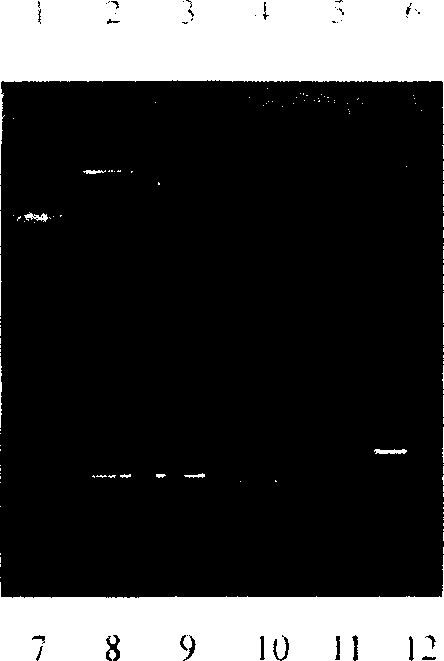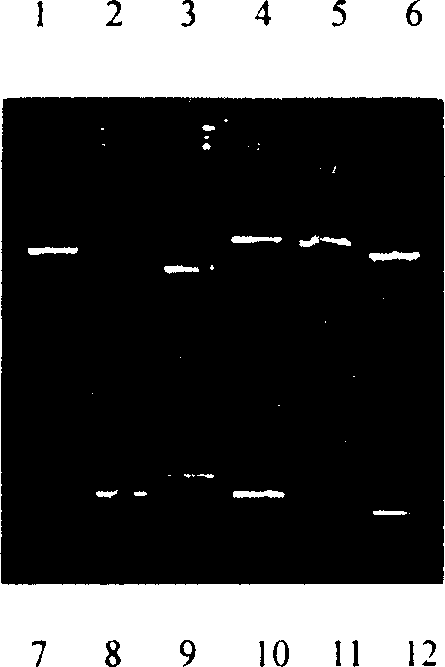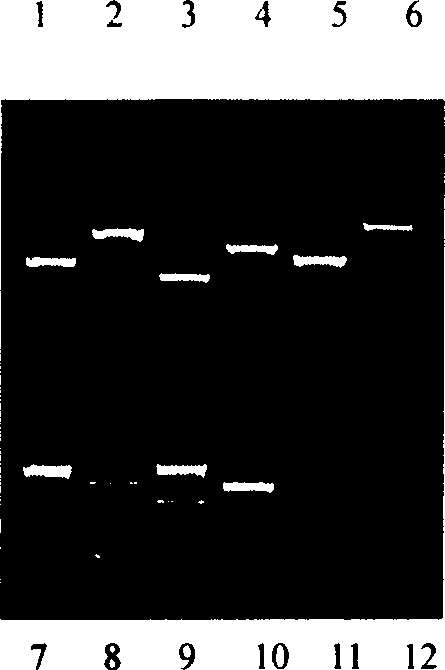Method for distinguishing different plant arising from plant mitochondrion sequence
A mitochondrial and mitochondrial genome technology, applied in the field of biology, can solve the problems of mitochondrial genomes, such as inconvenience, complex and diverse structures, and large differences in changes, and achieve the effects of easy promotion and application, reduced costs, and expanded scope and quantity
- Summary
- Abstract
- Description
- Claims
- Application Information
AI Technical Summary
Problems solved by technology
Method used
Image
Examples
Embodiment 1
[0024] The extraction of embodiment 1 plant genome DNA:
[0025] Add 20ml of extraction buffer I to a 50ml centrifuge tube and preheat in a 60°C water bath. Rice seedlings or leaves 5-10g, cut into pieces, add liquid nitrogen in a mortar, grind into powder, immediately pour into a preheated centrifuge tube, shake vigorously to mix, keep warm in a 60°C water bath for 30-60min (long time, DNA high yield), shaking occasionally. Add 20ml of chloroform / amyl alcohol / ethanol solution, mix by inversion (gloves are required to prevent damage to the skin), let stand at room temperature for 5-10 minutes, and separate the aqueous phase and the organic phase (re-mix if necessary). Centrifuge at 5000rpm for 5min at room temperature. Carefully pipette the supernatant to another 50ml centrifuge tube, add 1 times the volume of isopropanol, mix well, and leave it at room temperature for a while to form flocculent DNA precipitates. Add 1ml TE to 1.5ml eppendorf. Use a hooked glass rod to rem...
Embodiment 2
[0026] The extraction of embodiment 2 plant mitochondrial genomes:
[0027] Required reagents
[0028] STE buffer: 400 mM sucrose, 50 mM Tris (pH7.8), 20 mM EDTA, 0.2% bovine serum albumin, 0.2% β-mercaptoethanol.
[0029] ST buffer: 400 mM sucrose, 50 mM Tris (pH 7.8), 20 mM EDTA, 0.1% bovine serum albumin.
[0030] TEN buffer: 100 mM Tris (pH 7.2), 50 mM EDTA, 100 mM NaCl and 0.2% β-mercaptoethanol.
[0031] NETF buffer: 1.25M NaCl, 50 mM EDTA, 50 mM Tris (pH 8.0), 50 mM NaF.
[0032] 1M magnesium acetate
[0033] 5M ammonium acetate
[0034] 5M potassium acetate
[0035] 20% SDS
[0036] 1M EDTA
[0037] Phenol (saturated with Tris (pH8.0))
[0038] Phenol:chloroform=1:1
[0039] Chloroform: isoamyl alcohol (24:1)
[0040] 96% and 70% ethanol
[0041] Isopropanol
[0042] DNase
[0043] (1) Separation of mitochondria
[0044] 1) Prepare STE buffer. Add BSA and β-mercaptoethanol.
[0045] 2) Rinse the sample (0°C), and the subsequent steps are all required to...
Embodiment 3
[0070] Embodiment 3 uses primers to carry out PCR amplification
[0071] Reagents required:
[0072] ①10×PCR reaction buffer: 500mmol / L KCl, 100mmol / L Tris·Cl, at 25°C, pH 9.0, 1.0% Triton X-100.
[0073] ② MgCl 2 : 25mmol / L.
[0074] ③ 4 kinds of dNTP mixture: each 2.5mmol / L. That
[0075] ④Taq DNA polymerase 5U / μl.
[0076] ⑤ T4 DNA ligase and ligation buffer.
[0077] ⑥ pUC plasmid digested with Sma I and added with dT.
[0078] ⑦Other reagents: mineral oil (paraffin oil), 1% agarose, 5×TBE, phenol:chloroform:isoamyl alcohol (25:24:1), absolute ethanol and 70% ethanol.
[0079] PCR reaction steps
[0080] ①Mix the following reagents in sequence
[0081] 35 μl H 2 o
[0082] 5 μl 0× PCR reaction buffer
[0083] 4μl 25mmol / L MgCl 2
[0084] 4 μl of 4 dNTPs
[0085] 0.5 μl upstream primers (Table 1)
[0086] 0.5 μl downstream primers (Table 1)
[0087] 0.5μl template DNA (about 1ng)
[0088] Centrifuge for 5 seconds after mixing.
[0089] ②Heat the mixture at ...
PUM
 Login to View More
Login to View More Abstract
Description
Claims
Application Information
 Login to View More
Login to View More - R&D
- Intellectual Property
- Life Sciences
- Materials
- Tech Scout
- Unparalleled Data Quality
- Higher Quality Content
- 60% Fewer Hallucinations
Browse by: Latest US Patents, China's latest patents, Technical Efficacy Thesaurus, Application Domain, Technology Topic, Popular Technical Reports.
© 2025 PatSnap. All rights reserved.Legal|Privacy policy|Modern Slavery Act Transparency Statement|Sitemap|About US| Contact US: help@patsnap.com



